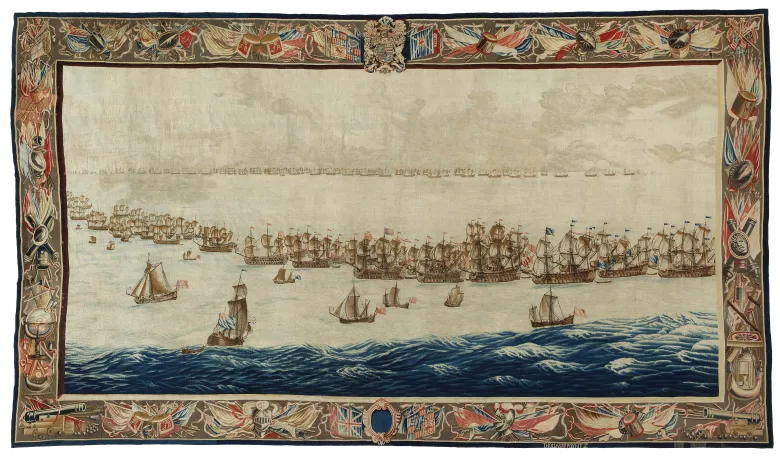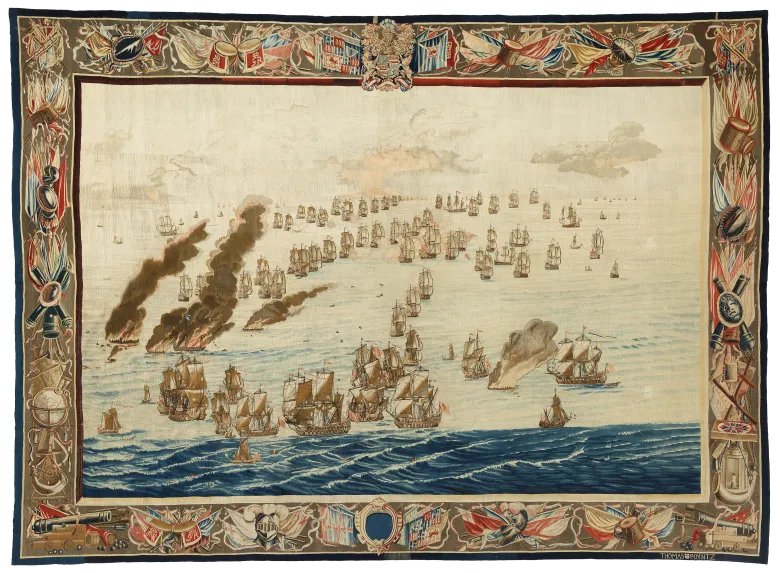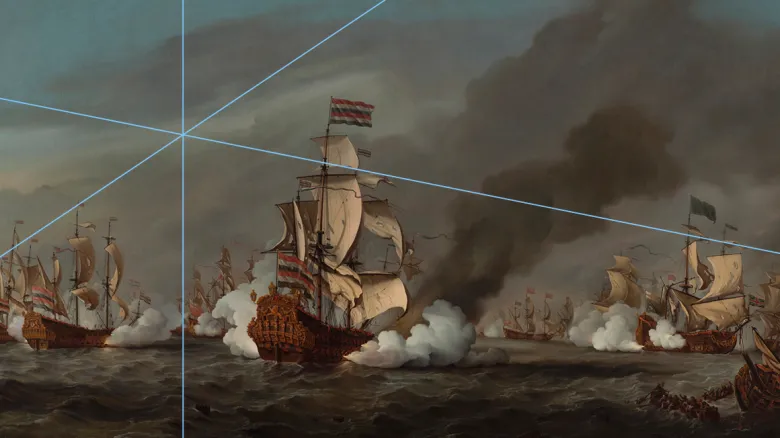The National Maritime Museum in Amsterdam (Het Scheepvaartmuseum) has purchased two rare, royally commissioned tapestries designed by Willem van de Velde the Elder (1611-1693) in England. The tapestries mark the significance of shared Anglo-Dutch heritage. The acquisition is the largest in the history of the museum. The artworks arrived at the museum earlier this week and will be on public display from 4 June 2021.
‘The Van de Velde Tapestries remind us of our shared cultural heritage. The acquisition is not only welcomed, but highly appropriate and a symbol of the strong and continuing connections between Britain and the Netherlands.‘ – Sue Prichard, Senior Curator of Arts, Royal Museums Greenwich
Wide support from art funds and British museums
The National Maritime Museum in Amsterdam (Het Scheepvaartmuseum) considered purchasing just one tapestry, but an additional contribution from the Dutch art fund Vereniging Rembrandt, and close consultation with colleagues from several museums in the UK, enabled the museum to keep both tapestries together. The biggest acquisition ever by the National Maritime Museum in Amsterdam was made possible with the generous support of a large number of Dutch sponsors.

The Fleets drawn up for Battle, woven after a design by Willem van de Velde the Elder, 5,87 x 3,30 metres, woven after 1685.
World-class artworks
The tapestries are part of a series of six which depict various scenes from the Battle of Solebay in 1672. A first set was commissioned by King Charles II shortly after the battle and which is still in the Royal Collections, with one tapestry on permanent loan to the National Maritime Museum in Greenwich. Thirteen years later Charles’s brother, King James II, commissioned a second set of six tapestries depicting the battle. This second set of six, which has been in private hands since the late seventeenth century, was broken up for sale in 1914. Four tapestries from this set are currently in American museum collections, but not on public display. The two tapestries recently acquired by the National Maritime Museum in Amsterdam are from the second set and were the last two that will ever appear on the art market. Prior to their acquisition by the museum, the two tapestries have been restored with great care in the UK.
Van de Velde exhibition in Amsterdam
The tapestries will be on display from the 4th of June. This is in runup to the grand exhibition about Willem van de Velde Father & Son, expected from October 1 2021 to March 27 2022. Given its size and scope, this retrospective exhibition will be a world first. After the exhibition, which will be on display until 5 April 2021, the tapestries will remain on public display in the museum permanently. For more information about the retrospective exhibition of artists Willem van de Velde the Elder and his son Willem van de Velde see www.hetscheepvaartmuseum.com/vandevelde.
Willem Van de Velde the Elder
Willem van de Velde the Elder (1611-1693) is widely regarded as one of the most eminent Dutch maritime artists of the seventeenth century. His meticulous and elaborate pen-paintings were very popular in high society and affluent circles all over Europe. Van de Velde and his son Willem, also a celebrated maritime artist, settled in England in the winter of 1672-1673 to work at the royal court on the invitation of King Charles II. There, in addition to various pen-paintings and a few oil paintings, Van de Velde the Elder created the designs for a series of imposing tapestries that were produced at the Mortlake Tapestry Works near London. The tapestries highlight the skill and versatile talent of Van de Velde the Elder. The tapestries are an important addition to the existing collection of sketches, drawings, pen-paintings and paintings of Willem van de Velde the Elder and his son Willem van de Velde the Younger the National Maritime Museum (Het Scheepvaartmuseum).
Battle of Solebay
The tapestries depict two scenes from the battle that took place off the east coast of England, near Solebay in Suffolk, on 7 June 1672. The naval engagement between the Dutch and joint English-French fleet was the opening battle of the Third Anglo-Dutch War (1672-1674). The Dutch fleet of over a 100 warships and 20,000 crew members was commanded by Lieutenant Admiral Michiel Adriaensz de Ruyter. On the day of the battle Van de Velde the Elder was present and, as an embedded war correspondent, captured the unfolding events at sea in several sketches onboard a Dutch sailing boat. He later made more elaborate drawings of the battle in the comfort of his own studio. Although the outcome of the naval battle remained undecided, it was celebrated as a victory on both sides.

The Burning of the Royal James (Later in the Day), woven after a design by Willem van de Velde the Elder, 4,57 x 3,30 metres, woven after 1685.
Royal commission
After he settled in Greenwich, Van de Velde the Elder adapted his original drawings for the design of the series of tapestries as part of two royal commissions, first by King Charles II in ca. 1672 and in 1685 for a second series at the request of King James II. These tapestries were woven by Thomas Poyntz at the Mortlake Tapestry Works near London. The largest tapestry, measuring an impressive 6 by 3.3 metres in size, depicts the formation of the fleets preceding the battle. The second tapestry of 4.5 by 3.3 metres depicts a successful Dutch fireship attack on the Earl of Sandwich’s imposing English flagship Royal James.
